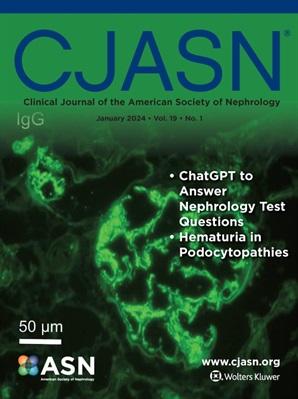Combination Automated Microfluidics Measurement of Urine C-C Motif Ligand 2, CXC-Motif Chemokine 9, CXC-Motif Chemokine 10, and Vascular Endothelial Growth Factor A for Monitoring Patients with a Kidney Transplant.
IF 8.5
1区 医学
Q1 UROLOGY & NEPHROLOGY
Clinical Journal of the American Society of Nephrology
Pub Date : 2025-05-01
Epub Date: 2025-03-11
DOI:10.2215/CJN.0000000666
引用次数: 0
联合自动微流体测量尿液CCL2, CXCL9, CXCL10和VEGF-A用于监测肾移植患者。
背景:最近的研究表明,在血清肌酐水平稳定的儿童和成人肾移植受者中,多达 36% 的患者会在监测活检中发现急性排斥反应。本研究的目的是开发和验证一种风险算法,利用一种新型自动平台识别低风险和高风险患者,该平台可同时高精度测量尿液中的 CCL2、CXCL9、CXCL10 和 VEGF-A:我们设计了一项多中心观察性研究,以评估在成人和儿童受者肾脏活检监测或指示时收集的 517 份库存样本中,尿液 CCL2、CXCL9、CXCL10 和 VEGF-A 的性能。在训练集中开发了结合所有四种分析物的风险算法,随后在三个实验室对另外两个儿科队列(N=174)进行了验证:结果:自动化平台的处理能力非常高,在 60-70 分钟内即可生成可重复的结果。分析最初在训练集(N=517)中进行,训练集包括正常(N=330)、急性排斥(N=92)或边缘排斥(N=95)的活检样本。我们发现,每个生物标志物都能独立区分正常活检和急性排斥反应活检(P < 10-5)。利用所有四种生物标记物的风险算法(score4)在对GFR稳定的患者进行因病活检和监测活检时,对急性排斥反应都有很好的诊断效果,优于任何单个生物标记物和估计的GFR评估。在三个实验室地点对另外两个儿科队列进行的验证测定显示了结果的稳健相关性;score4保持了卓越的诊断性能(75%的特异性和92%的阴性预测值):结论:尿液CCL2、CXCL9、CXCL10和VEGF-A的自动测定可区分肾移植受者的排斥反应低风险和高风险。我们认为,这种检测方法成本低、检测速度快、无需操作人员参与,因此可在移植后常规监测中为临床决策提供帮助。
本文章由计算机程序翻译,如有差异,请以英文原文为准。
求助全文
约1分钟内获得全文
求助全文
来源期刊
CiteScore
12.20
自引率
3.10%
发文量
514
审稿时长
3-6 weeks
期刊介绍:
The Clinical Journal of the American Society of Nephrology strives to establish itself as the foremost authority in communicating and influencing advances in clinical nephrology by (1) swiftly and effectively disseminating pivotal developments in clinical and translational research in nephrology, encompassing innovations in research methods and care delivery; (2) providing context for these advances in relation to future research directions and patient care; and (3) becoming a key voice on issues with potential implications for the clinical practice of nephrology, particularly within the United States. Original manuscript topics cover a range of areas, including Acid/Base and Electrolyte Disorders, Acute Kidney Injury and ICU Nephrology, Chronic Kidney Disease, Clinical Nephrology, Cystic Kidney Disease, Diabetes and the Kidney, Genetics, Geriatric and Palliative Nephrology, Glomerular and Tubulointerstitial Diseases, Hypertension, Maintenance Dialysis, Mineral Metabolism, Nephrolithiasis, and Transplantation.

 求助内容:
求助内容: 应助结果提醒方式:
应助结果提醒方式:


